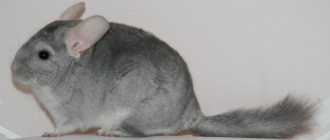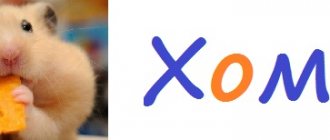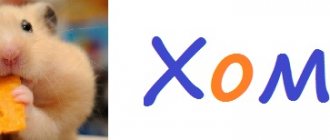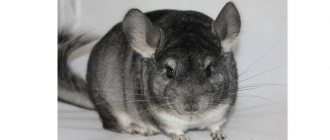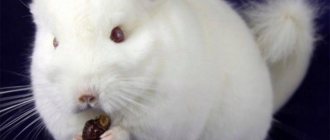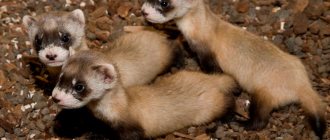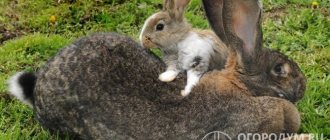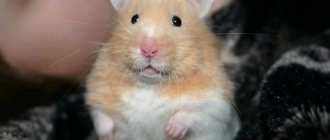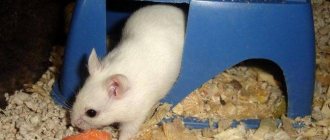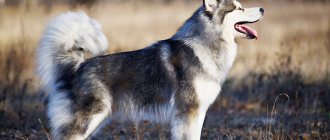03/24/2021 11,445 Chinchillas
Author: Olga
So that the chinchilla could survive in its natural habitat, nature gave it fur of modest colors. The most recognizable color of a chinchilla's coat is white on the tummy, gray on the back and sides. This is the basic color, the so-called standard. Shades from light ash to graphite are the framework within which this gray classic is designed. The breeders decided to change the scenario of nature and the chinchillas themselves, as they were a century ago.
[Hide]
One is gray, the other is white - colors
Experiments on crossing individuals have been ongoing for several decades in order to obtain skins of extraordinary beauty. The result of this work was such new shades as violet, diamond, sapphire, ebony...
Let's figure out exactly what shades these and other, no less spectacular, names encode. Let's find out who the degu and the Siberian chinchilla are. Does Siberian coloring even exist? What does the color of a degu look like? But before we answer these questions, let's talk about the basic gray color.
Strictly speaking, what we call “gray”, meaning the color of a wild rodent, is actually a more complex, three-color color. Just imagine a hair pigmented from tip to root with black, white and gray. It is very difficult to notice the zonality of coloring, because these hairs are located extremely close to each other.
The three-level coloring of the hairs, invisible to the eye, creates an amazing optical effect. – Depending on the depth of black, the purity of white and the shade of gray, the result is fur colored gray with varying degrees of intensity.
The highlight of the color is the silver tint or the so-called veil. These are the short-tailed chinchilla and the long-tailed chinchilla. – This is the name of two species of rodents of the chinchilla family. And the colors that these chinchilla breeds have in nature are standard.
The standard color has four types. Each type corresponds to the degree of color saturation: moderately dark standard, dark standard, extra-dark standard and medium standard. The most valuable is considered to be an individual of the extra-dark standard color.
The restrained beauty of the wild chinchilla is challenged by its domesticated relatives. They are expanding the number of species of rodents in the chinchilla family. And belonging to one or another depends not on the length of the tail, but on the color.
Popular colors of chinchillas
So, today many individuals of various stripes have been bred, the most popular of which are:
- White Wilson. Wilsons have several types: from milky to dark silver. All Wilsons have black eyes and a white tail tip. Two white Wilsons are not planted because two Wilsons have little chance of producing viable young.
- Pastel. Varieties of colors: light pastel, dark pastel, extra-dark pastel, medium pastel. Pastel colored animals darken with age.
- Black velvet. These animals have a white belly, black back and sides. The muzzle of the animal Black Velvet is also black. The more clearly the color contrast is manifested, the higher the individual is valued. Wilsons are often chosen as a pair for Black Velvet. And like the Wilsons, two Black Velvets are not planted together.
- Ebony. The ebony gene affects the degree of coloration of the tummy. If the animal's belly fur matches the color of its main fur, then it is real ebony.
- Homobeige. Homobeige fur is distinguished by uniform coloring. Homobeige animals have pink ears.
- Heterobeige. Unlike homobeige, heterobeige coats are colored unevenly: the tips of the hairs, like the undercoat, are darker than the main tone.
- Degu. Degu is a dwarf chinchilla. In nature, degus “wear” brown fur coats with a yellowish or grayish tint. It doesn't sound as impressive as, say, sapphire and diamond. And it doesn’t look as radical as, for example, an albino. However, breeders liked the small degu chinchillas. They try to recreate the degu color by crossing individuals of different colors.
Possible variations that result from crossing
When crossing animals of different colors, different colors are obtained. The number of possible options is so large that it is simply impossible to list them. Among them are White Velvet, Heteroebony, Homoebony and others.
Rare and spectacular chinchilla colors
Rare colors of rodents of the chinchilla family are:
- Sapphire. A blue chinchilla with a pearly white belly and pink ears: meet Sapphire. Individuals of the Sapphire color have low viability, so they are rare in their pure form.
- Royal Persian Angora. This is a long-tailed chinchilla, whose colors can be any. The most valuable types of Royal Persian Angoras are diamond and sapphire. The “royal” feature of Angoras is their long, beautiful hair. Thanks to their rich wool, Royal Angoras, even of standard color, look luxurious.
- White and pink coats belong to animals with beige and white genes. These genes make themselves felt in different ways, which is why there are several subspecies of pink and white colors. So, the white-pink color is both white, with beige marks, and beige, with white spots. But no matter what subspecies the white-pink color is classified as, the color of its owner’s ears will always be pink. To produce pink and white cubs, both the female and the male must be carriers of four genes at once. This is why white and pink colors are not common. Breeders really like individuals of this color, because the white and pink shade has a royal look!
- Violet. Animals of this color do not always have purple fur. The fur coat can be gray or purple. But a shade of violet is always present in the pigmentation of the nose. In order not to lose the violet gene, violet-colored individuals are planted exclusively with each other. However, sometimes breeders deviate from this rule, breeding individuals in shades of violet and black velvet.
So who is the Siberian chinchilla? Having listed a large number of colors, we still haven’t met the Siberian. It turns out that the Siberian chinchilla is a breed of cat. Attempts to find a “Siberian” shade (or anything else “Siberian”) in rodents of the chinchilla family are in vain.
But Siberian cats “borrowed” their zone-colored hairs from rodents. The surprisingly soft fur of Siberian cats added similarity to animals from different orders.
Results
These pussies can be the subject of a lucrative business. A description of the chinchilla breed with a photo and name will help in choosing animals. When breeding these rodents, keep in mind that gray and beige rodents are easier to breed, but are more common. They are cheaper. Sapphire and violet are rare colors, more expensive, but much more difficult to breed. The breeder has to study many nuances and strictly follow them. Therefore, to maintain the financial well-being of the farm, it is necessary to think through a reasonable balance between breeding different species of this beautiful and amazing animal.
Work continues to breed new species. Scientists from different countries are studying this problem. The animal is of great interest both as a pet and for industrial purposes.
Chinchillas support the household. They are attached to their owner tenderly and for a long time. Of great interest is the breeding of animals in pairs, when you can observe love and friendship that can be envied.
Genetic color calculator for chinchillas
The colors of chinchillas are very diverse. How to breed an individual of the desired color? Understanding the complex interweaving of pet genes can be quite difficult. A tool such as a genetic calculator comes to the aid of a chinchilla breeder. Using a genetic calculator, you can determine which color offspring is most likely to be born.
So, using this calculator, you can calculate that a Homoebony mother and a Homoebony dad will have almost 64% probability of producing Gomoebony cubs. There is a 22% chance that their babies will have the Extra-Dark Ebony color. The possibility of these parents having Ebony-dark babies is 10%. And in only 4% of cases, such a couple gives birth to Ebony-light and Ebony-medium cubs.
Chinchilla breeds: Shades and breeds of animals with photographs and names
Many believe that chinchilla breeds are fiction, and that the animals can be exclusively gray, the way they are most often seen in pet store windows and in photos on the Internet. However, this opinion is wrong. Breeders have been working for decades to ensure that the breeds and shades of these funny rodents only increase.
Below we will introduce you to the varieties of chinchilla colors and their breeds offered in nurseries.
Video “Chinchilla colors”
This video features White and Pink Chinchilla, Angora Chinchilla, Beige Chinchilla, White Wilson. Here you can also see individuals of such colors as Brown Velvet, Homoebony, Homobeige, White Velvet, White Sapphire. The authors of the video also did not forget about the colors Albino, White Violet, Blue Diamond, Pastel, Ebony, Violet, Homobeige Sapphire, Sapphire, Black Velvet.
Was this article helpful?
Thank you for your opinion!
The article was useful. Please share the information with your friends.
Yes (75.00%)
No (25.00%)
X
Please write what is wrong and leave recommendations on the article
Cancel reply
Rate the benefit of the article: Rate the author ( 5 votes, average: 4.80 out of 5)
Discuss the article:
What to wear with a chinchilla fur coat in the 2021-2022 season
But if you become the owner of a chinchilla fur coat, the question involuntarily arises of what to wear with a chinchilla fur coat.
- First of all, it is necessary to exclude other accents, leaving this right to the fur coat.
- There is no need to add complex fur design; simple and brief additions will suffice. This model will serve as an excellent clothing option for a weekend evening or special occasions.
- No less stylish is the use of such a model with a casual ensemble, for example, with jeans and a beautiful pullover.
Coco Chanel said that truly luxurious things should be “only” for fun and always a little sloppy.
[Total: 4 Average: 2.5/5]
Maintenance and care
Like any decorative pets, chinchillas need to be provided with maximum comfort in the apartment, outside of which they very rarely go. Take care of safety: if you decide to walk your cat on the loggia, do not forget to close the windows or cover open window openings with netting. Chinchillas, British and Scottish dogs are not the most jumping creatures, but sometimes they want to frolic too, so buy your animal at least a small play set. A cozy bed or basket is also necessary - representatives of this clan are comfort-dependent and love soft mattresses.
Hygiene
Owners of Persian chinchillas will have to put in the most effort. Adults should be washed at least once a month, and kittens every two weeks. In addition, you will have to spend time searching for special shampoo and balm. Do you want to preserve the exquisite color of your cat’s “fur coat”? Look for cosmetics formulated for animals with light fur. Systematic scratching also cannot be avoided, so if you don’t want to devote a lot of time to the image of your pet, pay attention to chinchillas from the British and Scottish genus. There is much less fuss with their wool.
British chinchillas are washed only when they are really dirty. In other cases, you can get by with collecting dead hairs with a damp cloth or rubber glove. A little more work with representatives of the semi-longhaired variety of the breed. These comrades will have to be fully combed, and during periods of seasonal molting they will even have to be treated with a furminator.
Care for the eyes and ears of chinchillas of all breeds is standard. The organs of vision are examined daily, the ear funnels are examined once a week. Mucous lumps in the corners of the eyelids are removed with a clean cloth, which can be moistened in cold boiled water or chamomile infusion. Do not forget that both the Persians and the British are characterized by excessive tearfulness. Usually tear tracks leave unsightly marks on the silver fur, so to keep your pet looking perfect, wipe away tears often and buy a special lightening powder for the area around the eyes.
It’s great if you have trained your chinchilla to adequately accept brushing its teeth with a classic brush. If you can't get your pet to use this device, consider alternatives: solid treats that remove plaque, as well as oral lotions like Cliny, which are added to drinking water.
Feeding
There is no consensus on how to properly feed a chinchilla kitten. Most nurseries give preference to high-quality dry food with a high protein content and a minimal percentage of grains. Typically, such varieties are completely balanced, so all that is required from the owner is to measure out the correct portion to the animal, which will satiate, but will not cause excess weight gain. Another advantage of “drying” is that the animals that eat it do not need to brush their teeth, since dry croquettes perfectly “erase” any type of plaque.
Veterinarians continue to “vote” for natural products: lean meat and offal, low-fat fermented milk, fish fillet, vegetables (except legumes and potatoes) and fruits. Bakery products, any food from the master's table and meat delicacies intended for people are strictly prohibited. At the same time, it is important to understand that it is difficult to balance the diet with food alone, so from time to time you will have to grow grass for your pet on the windowsill, buy dietary supplements with taurine, as well as vitamins for the beauty of the coat. By the way, about supplements: at different ages, chinchillas need certain dietary supplements. If kittens need complexes with a large amount of minerals, then older individuals need vitamin D, calcium and phosphorus.
